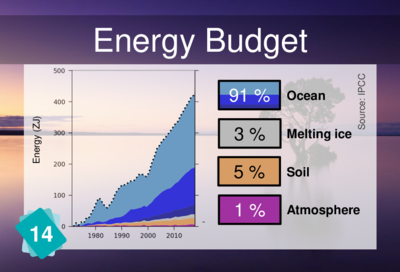En-en adult card 14 energy budget: Difference between revisions
X4resilience (talk | contribs) (corrected all the links to the right URL) |
|||
| Line 25: | Line 25: | ||
=== Full version === | === Full version === | ||
If you choose to keep this card, you need to remember the first principle of thermodynamics: energy is conserved. Players may draw links from Energy budget to [[En-en adult card 17 increase in water temperature|Rising Water Temperatures]] and [[En-en adult card 21 temperature rise| | If you choose to keep this card, you need to remember the first principle of thermodynamics: energy is conserved. Players may draw links from Energy budget to [[En-en adult card 17 increase in water temperature|Rising Water Temperatures]] and [[En-en adult card 21 temperature rise|Rising Air Temperatures]], then links from [[Rising Air Temperatures]] to [[En-en adult card 16 melting of glaciers|Melting glaciers]] and [[En-en adult card 17 increase in water temperature|Rising Water Temperatures]] to [[En-en adult card 18 melting of sea ice|Melting Sea Ice]] and [[En-en adult card 19 melting of ice sheets|Melting Ice Sheets]]. By doing this, they consider that the air and water warm up, and then they melt the pack ice, glaciers and ice caps. But if a calorie has passed through the water and finally contributes to melting the pack ice from below, then it is no longer in the water. | ||
=== Explanation advice === | === Explanation advice === | ||
| Line 32: | Line 32: | ||
== Correction== | == Correction== | ||
===Causes=== | ===Causes=== | ||
*[[En- | *[[En-en adult card 15 radiative forcing|Radiative forcing]] | ||
* [[En- | * [[En-en adult card 42 weakening gulf stream|Weakening Gulf Stream]] | ||
=== Consequences === | === Consequences === | ||
Revision as of 14:49, 15 December 2021
Card #14: Energy Budget
This graph explains where the energy accumulated on Earth due to radiative forcing goes. It warms up the ocean, melts ice, dissipates into the ground and warms up the atmosphere.
Explanation
On the graph, you can see several colours that represent, from top to bottom:
- In light blue, the upper layer of the ocean, between 0 and 700m
- In dark blue, the lower layer of the ocean, between 700m and 2000m
- In white, the different types of ice
- In orange, the soil
- In purple, the atmosphere.
The dotted lines represent uncertainty.
Facilitation advice
Simplified version
This card can be removed for the simplified version, at the same time as the radiative forcing and aerosols.
Full version
If you choose to keep this card, you need to remember the first principle of thermodynamics: energy is conserved. Players may draw links from Energy budget to Rising Water Temperatures and Rising Air Temperatures, then links from Rising Air Temperatures to Melting glaciers and Rising Water Temperatures to Melting Sea Ice and Melting Ice Sheets. By doing this, they consider that the air and water warm up, and then they melt the pack ice, glaciers and ice caps. But if a calorie has passed through the water and finally contributes to melting the pack ice from below, then it is no longer in the water.
Explanation advice
A tip to simplify the explanation of this card is to rename the following cards. An increase in temperature is an increase in energy, and melting is also an increase in energy. The five cards then become Increase in the energy level of water, air, sea ice... And the players will understand that these five cards have to be put at the same level. So if a calorie that is in the water contributes to melting the pack ice, once the pack ice has melted, this calorie is no longer in the water. The water has cooled down. In this case, should the calorie be counted in the "ocean" or "melting ice" part? Answer: in the melting part of the ice. You can't count this calorie twice.
Correction
Causes
Consequences
- Melting glaciers
- Rising Water Temperatures
- Melting Sea Ice
- Melting Ice Sheets
- Rising Air Temperatures
Other possible links
Other consequences
- Permafrost If we take the idea of energy conservation all the way, we can link the energy budget to the thawing of permafrost.
To go further
Figures
Oceans cover 71% of the earth's surface, with an average depth of 4 km. If air were reduced to the same density as water, its height would be 10m. The ocean has a very high density, which explains why it absorbs most of the energy related to GHGs emitted by man.
Videos
Video presentation of the map by Rodolphe Meyer (French)
